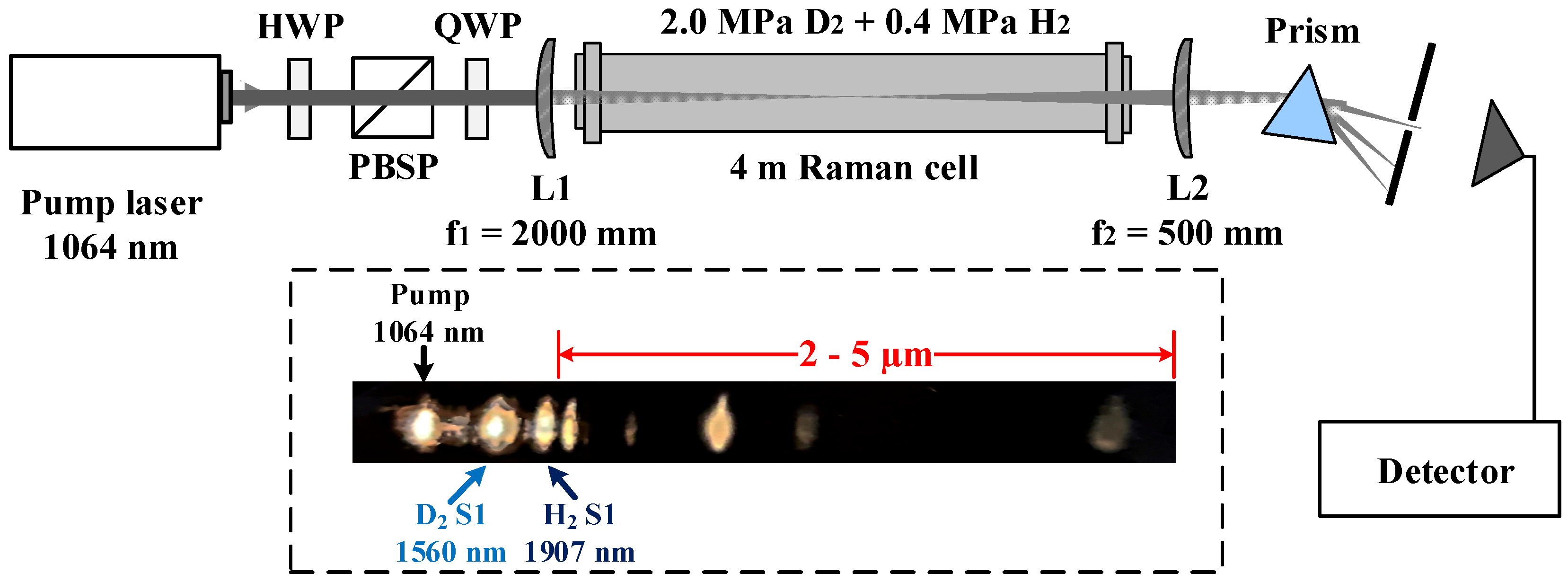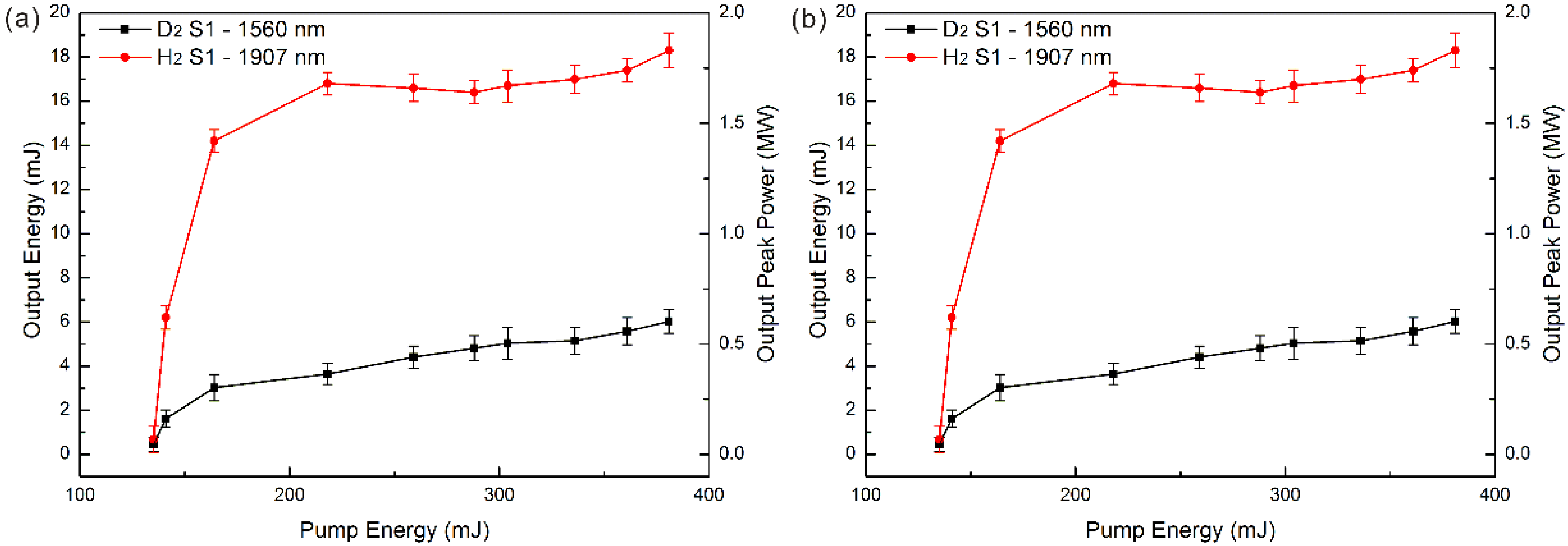Mid-Infrared Multispectral Gaseous Stimulated Raman Scattering Laser
Abstract
:Featured Application
Abstract
1. Introduction
2. Experimental Setup
3. Results and Discussion
3.1. High-Power Mid-IR Laser at 4432 nm
3.2. 2–6 μm Multispectral Mid-IR Raman Laser
4. Conclusions
Author Contributions
Funding
Institutional Review Board Statement
Informed Consent Statement
Data Availability Statement
Conflicts of Interest
References
- Vodopyanov, K.L. Laser-Based Mid-Infrared Sources and Applications; John Wiley & Sons: Hoboken, NJ, USA, 2020. [Google Scholar]
- Walsh, B.M.; Lee, H.R.; Barnes, N.P. Mid infrared lasers for remote sensing applications. J. Lumin. 2016, 169, 400–405. [Google Scholar] [CrossRef]
- Jackson, S. Towards high-power mid-infrared emission from a fibre laser. Nat. Photonics 2012, 6, 423–431. [Google Scholar] [CrossRef]
- Werle, P.; Slemr, F.; Maurer, K.; Kormann, R.; Mücke, R.; Jänker, B. Near- and mid-infrared laser-optical sensors for gas analysis. Opt. Lasers Eng. 2002, 37, 101–114. [Google Scholar] [CrossRef]
- Gandolfi, M.; Tognazzi, A.; Rocco, D.; de Angelis, C.; Carletti, L. Near-unity third-harmonic circular dichroism driven by quasi-bic in asymmetric silicon metasurfaces. arXiv 2021, arXiv:2102.08027. [Google Scholar]
- Koshelev, K.; Tang, Y.; Li, K.; Choi, D.-Y.; Li, G.; Kivshar, Y. Nonlinear Metasurfaces Governed by Bound States in the Continuum. ACS Photonics 2019, 6, 1639–1644. [Google Scholar] [CrossRef] [Green Version]
- Pitruzzello, G.; Krauss, T.F. Photonic crystal resonances for sensing and imaging. J. Opt. 2018, 20, 073004. [Google Scholar] [CrossRef]
- Tognazzi, A.; Rocco, D.; Gandolfi, M.; Locatelli, A.; Carletti, L.; De Angelis, C. High Quality Factor Silicon Membrane Metasurface for Intensity-Based Refractive Index Sensing. Optics 2021, 2, 193–199. [Google Scholar] [CrossRef]
- Li, D.J.; Yang, G.L.; Chen, F.; Xie, J.J.; Zhang, L.M.; Guo, J.; Shao, C.L.; Peng, Z.Q.; Lu, Q.P. Stimulated rotational Raman scattering at multiwavelength under tea CO2 laser pumping with a multiple-pass cell. Laser Phys. 2012, 22, 937–940. [Google Scholar] [CrossRef]
- Supradeepa, V.R.; Nichsolson, J.W.; Headley, C.E.; Yan, M.F.; Palsdottir, B.; Jakobsen, D. A high efficiency architecture for cascaded Raman fiber lasers. Opt. Express 2013, 21, 7148–7155. [Google Scholar] [CrossRef]
- Shen, C.; Cai, X.; Sang, Y.; Zheng, T.; Li, Z.; Liu, D.; Liu, W.; Guo, J. Investigation of multispectral SF6 stimulated Raman scattering laser. Chin. Opt. Lett. 2020, 18, 051402. [Google Scholar] [CrossRef]
- Sabella, A.; Piper, J.A.; Mildren, R.P. Diamond Raman laser with continuously tunable output from 3.38 to 3.80 μm. Opt. Lett. 2014, 39, 4037–4040. [Google Scholar] [CrossRef]
- Cheng, P.; Zhao, J.; Xu, F.; Zhou, X.; Wang, G. Diode-pumped mid-infrared YVO4 Raman laser at 2418 nm. Appl. Phys. A 2017, 124, 5. [Google Scholar] [CrossRef]
- Li, Z.; Huang, W.; Cui, Y.; Wang, Z. Efficient mid-infrared cascade Raman source in methane-filled hollow-core fibers operating at 28 μm. Opt. Lett. 2018, 43, 4671–4674. [Google Scholar] [CrossRef] [PubMed]
- Gladyshev, A.V.; Kosolapov, A.F.; Khudyakov, M.; Yatsenko, Y.P.; Kolyadin, A.; Krylov, A.A.; Pryamikov, A.D.; Biriukov, A.S.; Likhachev, M.E.; Bufetov, I.A.; et al. 4.4-μm Raman laser based on hollow-core silica fibre. Quantum Electron. 2017, 47, 491–494. [Google Scholar] [CrossRef]
- Gladyshev, A.V.; Kosolapov, A.F.; Khudyakov, M.M.; Yatsenko, Y.P.; Kolyadin, A.N.; Krylov, A.A.; Pryamikov, A.D.; Biriukov, A.S.; Likhachev, M.E.; Bufetov, I.A. 2.9, 3.3, and 3.5 μm raman lasers based on revolver hollow-core silica fiber filled by 1H2/D2 gas mixture. IEEE J. Sel. Top. Quantum Electron. 2018, 24, 1–8. [Google Scholar] [CrossRef]
- Wang, Y.; Dasa, M.K.; Adamu, A.I.; Antonio-Lopez, J.E.; Habib, S.; Correa, R.A.; Bang, O.; Markos, C. High pulse energy and quantum efficiency mid-infrared gas Raman fiber laser targeting CO2 absorption at 4.2 µm. Opt. Lett. 2020, 45, 1938–1941. [Google Scholar] [CrossRef]
- Gao, S.-F.; Wang, Y.-Y.; Ding, W.; Jiang, D.-L.; Gu, S.; Zhang, X.; Wang, P. Hollow-core conjoined-tube negative-curvature fibre with ultralow loss. Nat. Commun. 2018, 9, 1–6. [Google Scholar] [CrossRef] [Green Version]
- Björklund, G. Effects of focusing on third-order nonlinear processes in isotropic media. IEEE J. Quantum Electron. 1975, 11, 287–296. [Google Scholar] [CrossRef]
- Kleinman, D.A.; Ashkin, A.; Boyd, G.D. Second-Harmonic Generation of Light by Focused Laser Beams. Phys. Rev. 1966, 145, 338–379. [Google Scholar] [CrossRef]
- Bloembergen, N.; Bret, G.; Lallemand, P.; Pino, A.; Simova, P. Controlled stimulated Raman amplification and oscillation in hydrogen gas. IEEE J. Quantum Electron. 1967, 3, 197–201. [Google Scholar] [CrossRef]
- Chu, Z.; Singh, U.N.; Wilkerson, T.D. Multiple stokes wavelength generation in H2, D2, and CH4 for lidar aerosol measurements. Appl. Opt. 1991, 30, 4350–4357. [Google Scholar] [CrossRef] [PubMed]
- Ben Yehud, L.; Belker, D.; Ravnitzki, G.; Ishaaya, A.A. Competition between stimulated Raman and Brillouin scattering processes in CF_4 gas. Opt. Lett. 2014, 39, 1026. [Google Scholar] [CrossRef]
- Boyd, R. Nonlinear Optics, 2nd ed.; Academic Press: Amsterdam, The Netherlands, 2003. [Google Scholar]
- Yagi, T.; Huo, Y. Laser-induced breakdown in H2 gas at 248 nm. Appl. Opt. 1996, 35, 3183–3184. [Google Scholar] [CrossRef]
- Minck, R.W.; Hagenlocker, E.E.; Rado, W.G. Stimulated Pure Rotational Raman Scattering in Deuterium. Phys. Rev. Lett. 1966, 17, 229–231. [Google Scholar] [CrossRef]
- Perrone, M.R.; Piccinno, V.; De Nunzio, G.; Nassisi, V. Dependence of rotational and vibrational Raman scattering on focusing geometry. IEEE J. Quantum Electron. 1997, 33, 938–944. [Google Scholar] [CrossRef]
- Huang, W.; Li, Z.; Cui, Y.; Zhou, Z.; Wang, Z. Efficient, watt-level, tunable 1.7 µm fiber Raman laser in H2-filled hollow-core fibers. Opt. Lett. 2020, 45, 475–478. [Google Scholar] [CrossRef]
- Shen, C.; Cai, X.; Su, X.; Zheng, T.; Liu, J.; Chen, Y.; Jia, Y.; Liu, D.; Guo, J. Wavelength-tunable narrow-linewidth gaseous Raman laser. Appl. Opt. 2021, 60, 5465–5470. [Google Scholar] [CrossRef] [PubMed]





| Wavelength | SRS Process |
|---|---|
| 2071 nm | |
| 2266 nm | |
| 2604 nm | |
| 2920 nm | |
| 3322 nm | |
| 3743 nm | |
| 4432 nm | |
| 5431 nm |
Publisher’s Note: MDPI stays neutral with regard to jurisdictional claims in published maps and institutional affiliations. |
© 2021 by the authors. Licensee MDPI, Basel, Switzerland. This article is an open access article distributed under the terms and conditions of the Creative Commons Attribution (CC BY) license (https://creativecommons.org/licenses/by/4.0/).
Share and Cite
Shen, C.; Cai, X.; Zheng, T.; Jia, Y.; Liu, D.; Liu, J.; Guo, J. Mid-Infrared Multispectral Gaseous Stimulated Raman Scattering Laser. Appl. Sci. 2021, 11, 11875. https://doi.org/10.3390/app112411875
Shen C, Cai X, Zheng T, Jia Y, Liu D, Liu J, Guo J. Mid-Infrared Multispectral Gaseous Stimulated Raman Scattering Laser. Applied Sciences. 2021; 11(24):11875. https://doi.org/10.3390/app112411875
Chicago/Turabian StyleShen, Chencheng, Xianglong Cai, Tiancheng Zheng, Yuxi Jia, Dong Liu, Jinbo Liu, and Jingwei Guo. 2021. "Mid-Infrared Multispectral Gaseous Stimulated Raman Scattering Laser" Applied Sciences 11, no. 24: 11875. https://doi.org/10.3390/app112411875





